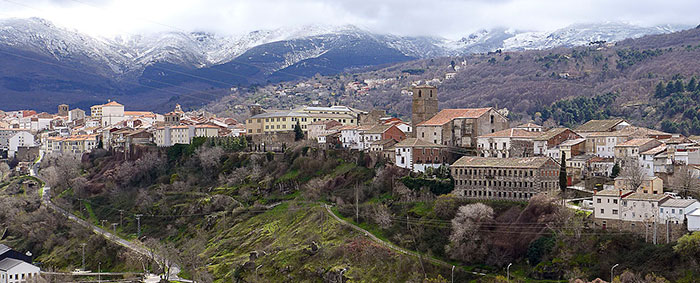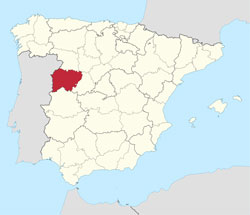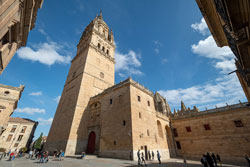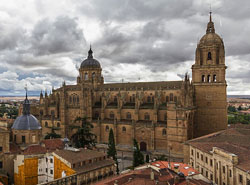Salamanca in Salamanca

The province of Salamanca is situated in north eastern Spain on the boarder of Portugal. It is the third largest of the nine provinces in the autonomous community of Castile and León.
 It borders on Portugal to the west, and on the provinces of Zamora (to the north), Valladolid (to the north east), Avila (to the east) and Cáceres in Extremadura (to the south).
It borders on Portugal to the west, and on the provinces of Zamora (to the north), Valladolid (to the north east), Avila (to the east) and Cáceres in Extremadura (to the south).
It is a province with enormous height differences: Its highest point is the peak of Canchal de la Ceja at 2428 MASL and the lowest is the valley of Salto de Saucelle at 116 MASL. The average height in the province is 823.
The province is traversed by several large rivers, the most important of which are the rivers Duero, Tormes, Águeda, Huebra and Yeltes. These rivers feed the province’s many big reservoirs. Salamanca has Spain’s third largest reservoir capacity at 3,400 cubic hectometres, only surpassed by Badajoz and Cáceres.
Salamanca has several protected areas dotted all over its geography, and some of its mountain ranges and the Iberian Plateau have been declared biosphere reserves.
The province of Salamanca covers 12,349.06 km2 and it has a population of 331,473 souls. 144,436 have their home in the capital of the same name.
The capital of Salamanca is situated in the north east of the province, and its history goes back in time to the first Iron Age 2,700 years ago, when the first inhabitants settled on the banks of the river Tormes.
Both the province and its capital are famous for the many remains from pre-Roman times, not least the so-called ‘verracos’ (boars), which are stone sculptures of pig or bull-like creatures that have been left from the times when the Vettones, a Celtic population, inhabited the area.
Salamanca city is home to Spain’s oldest, still functioning university. The University of Salamanca was founded in 1218 by Alfonso IX of León, and it became the first in Europe to be granted the title ‘university’ by royal decree by King Alfonso X in 1252.
As a university city, Salamanca can be likened to Oxford with ‘Salamanca Spanish’ being the Iberian answer to ‘Oxford English’. The university has several claims to fame:
- The first ever grammar book of Castellano (Castilian) was written there
- It accepted the world’s first female university academic, Beatriz Galindo.
- It employed the world’s first female university lecturer, Luisa de Medrano
- Both Christopher Columbus and Hernán Cortés studied at Salamanca University while preparing for their voyages to the Americas.
Salamanca’s historic centre is full of noteworthy buildings and was declared World Heritage Site by the UN in 1988.
 |
 |
| The Old Cathedral | The New Cathedral |
The area has two cathedrals – the ‘Old Cathedral’ and the ‘New Cathedral’. The former, also known as la Catedral de Santa María, was constructed between the 12th and the 14th centuries in Romanic and Gothic style.
The latter, la Catedral de la Asunción de la Virgen, was constructed between the 16th and 18th centuries in a mixture of Late Gothic, Renaissance and Baroque styles. It is Spain’s second largest cathedral, and its bell tower, 110 metres tall, is one of the tallest in the country.
The historic centre also comprises the principal building of the University of Salamanca, Escuelas Mayores, and the convent of San Esteban, where Christopher Columbus stayed while he prepared for his journey to the Americas.
The city of Salamanca was staunchly Republican at the beginning of the Civil War, but was soon defeated by Franco troops who arrested and shot the mayor early in the war.
From 1936 to 1937 the Palacio Episcopal in Salamanca was the residence and control centre of General Franco, and the city was home to the Falange organizations and some ministries.
During the Civil War, the Nationalist Faction gathered in Salamanca all the document they had confiscated in defeated territories and thus created a documentary archive of the war (Archivo General de la Guerra Civil Española). Part of the archive referred to Catalonia, and apart from that there was a wealth of documents that did not refer to this region.
Nonetheless, in 2006 the complete archive was transferred to Barcelona after a bitter dispute between the central government and Salamanca’s city council, and amid widespread popular demonstrations. As a result of this, the council renamed Gibraltar (a street which had been given its name in homage to the Salamanca troops who helped Alfonso XI in the conquer of Gibraltar), and gave it the name El Expolio – The Plunder.
The climate of Salamanca is cold and wet in winter and warm and dry in summer. It is the Spanish capital with the lowest average minimum temperature. The coldest temperature ever measured in Salamanca city was -12.6ºC, and the average number of days with precipitations of more than 1 mm per year is 63.8, 6.8 of which are snowy days.
The average maximum temperature in summer is 30ºC, and Salamanca boasts some 2,667 hours of sun a year.


